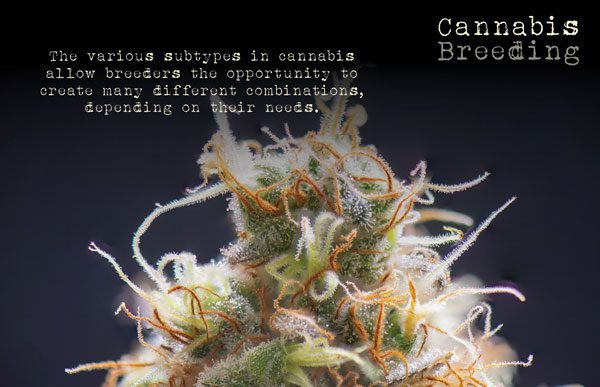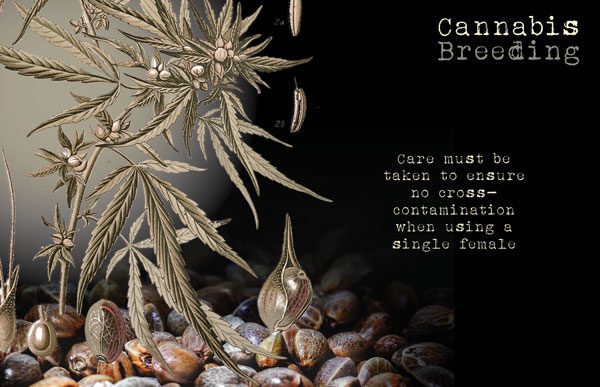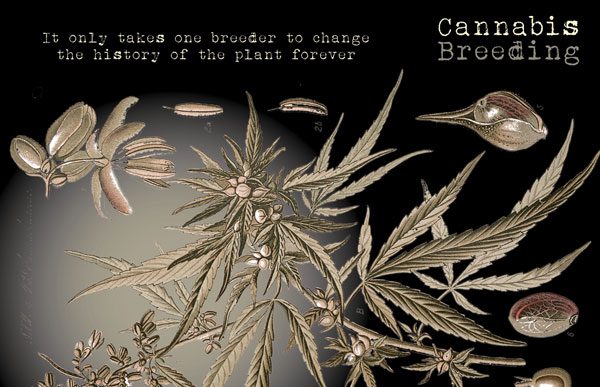Cannabis breeding allows home growers to create prized varieties that can sell for up to $10,000 or more per plant. It may seem like an intangible task, but it is much easier than one might think. All you need is a garden, time, observation, and a strong desire to create something new in cannabis genetics.
The Basics
All species of plants are either monoecious (meaning a single plant contains both male and female flowers) or dioecious (separate male and female plants). Sometimes, dioecious plants can morph into monoecious plants because of environmental stress.
Within these two categories, there are three subgroups, including plants that are long-day, short-day, and day-neutral. Long-day plants flower as the days grow longer in the spring (tulips). Short-day plants flower as the days shorten in the fall (cannabis). Day-neutral plants flower when they are the right age and size (corn).
Due to the various subtleties in plant growth development, some plants are harder to breed. For example, if a plant is monoecious, it has a higher chance that something besides your intended choice of pollen might mix. Isolating the male pollen from the female flowers is challenging since they are all on one plant. Thankfully, cannabis is a primarily dioecious plant that allows breeders to separate the male and female counterparts and select their favorites to breed together.

While cannabis is a dioecious plant, it falls within both the short-day and day-neutral subcategories. Cannabis sativa (longer flowering), Cannabis indica (shorter flowering), and Cannabis domestica (indoor varieties) are all short-day plants. When placed outdoors, these plants generally begin to flower after the summer solstice. Indoors, flowering starts when the light in the room drops to 12 hours on and 12 hours off. When short-day plants notice they have less light, they initiate flowering. However, there is still a different type of cannabis that operates on a different cycle: Cannabis ruderalis.
Cannabis ruderalis is a day-neutral plant. When growing these plants, there is a determined amount of time the plant will grow before it finishes, regardless of the light cycle. Strains created from these genetics are ideal for extreme northern climates where the daylight might be over 18 hours a day until cold nights become a problem. The various subtypes in cannabis allow breeders to create many different combinations, depending on their needs. When day-neutral strains combine with short-day varieties, a breeder can create strains that flower earlier outdoors, yet still maintain the desired qualities of short-day plants.
Tasty Terpenes
When it comes to medicine, we know that THC and CBD both have beneficial effects, but what about terpenes? Terpenes give cannabis its wonderful flavors, aromas, and side effects. There are reportedly over 20,000 terpenes in the plant and insect kingdom, and 200 are found in cannabis. But they aren’t always a given. Cannabis will always have a mild amount of terpenes naturally, but to get the full gamut of flavors and aromas, one must grow the plant correctly, and not all techniques are equal. Natural growing practices and regenerative soil techniques often show the best overall output in terpene production, medicinal quality, flavor, and burnability, leading to better quality medicine.
From sweets like chocolate to licorice and essential oils from lavender to cedar, there isn’t a fragrance or flavor that cannabis can’t emulate. There are even exotic flavors that go beyond anything one can find to eat! Tastes of incense and spice were found in the past Sativa strains of Acapulco and Columbian Gold, Thai, and many more. The flavors these strains would produce is indescribable; one can only hope to taste them even once in their lives, yet most will never find them. New waves of genetics often favor heavy yields, high THC, and short flowering times over flavor and effect. Great genetics of the past are falling victim to a style of selective breeding.
Understanding the flavors of cannabis is pivotal in creating great new genetic material. The breeding itself is straightforward and can be done in a 2×2 area if you follow certain precautions.
Step 1: Obtaining Seeds
Acquire “regular” seeds. Some cannabis seeds are feminized, which means they were treated with a silver solution, causing them to turn into a monoecious plant. Once a cannabis plant triggers to monoecious, it turns into a hermaphroditic form and pollinates itself, creating primarily female seeds. If you start with feminized seeds, you might not ever find a male.
Step 2: Planting
If the seeds are short-day and not a day-neutral, plant them and grow for approximately six weeks on a vegetative cycle (18-24 hours of light a day). Control the size of the plant with container size. After six weeks, most plants start showing their sex, regardless of light cycles. Females will begin to grow white hair out of the corners of the branch nodes. Males will develop a sort of ball-like flower along the edges of the branch nodes. Once you have identified the males from the females, choose your favorites.

Some breeders will take the time to flower out the females and keep a clone of each to ensure they are working with quality genetics, which is recommended. Others rely on a stem rub and structure evaluation. It is also possible to isolate several males and pollinate different branches of a single female to grow the offspring from each and find which male produced the best mate. Care must be taken to ensure no cross-contamination when using a single female. The best way to test male pollen is to cut clones (rooted branches) from a selected female mother plant and allow the different isolated males to breed the clones of the same female.
Step 3: Cross Breeding
Once you’ve selected your favorite male and female, induce flowering. Males will generally tower over females quickly into flowering and release their pollen long before the female ripens. If you’d like a lot of seeds and have no worry of harvesting any female flowers for a crop, leave the plants together. The female will be covered with seeds as it ripens.

If you only have a small number of seeds in your plant, isolate the male in a separate location, and gather a tiny amount of pollen from an open male flower. Deposit the pollen into something small like a bottle cap. A gentle tap of the male plant will allow a substantial amount of pollen to be released. After gathering it, seal off the container, change your clothes, and rinse off your body; you are covered in pollen, whether you realize it or not. Afterward, take the pollen into the female flowering room, turn off all fans and filters, use a toothpick to touch it, and gently feather a few female buds. Spray down the area with a mist bottle after the procedure to kill the excess pollen.
Step 4: Seed/Growth
Once you fertilize the female, let it finish flowering until you see fully developed, dark brown to black seeds popping out of each calyx (seed pod). Once the seeds are mature, harvest the plant and dry it like you would any other grow. Make sure you put a tray under your plant as it dries to catch any seeds released from their pods.
Step 5: Storing
Allow seeds to dry for a few weeks before storing them. Air-tight containers in a freezer offer the best chance for long-term storage. Seeds left to the elements may fail after a year. Seeds can sprout after decades of correct storage.
In The Driver’s Seat
With dry seeds, you can start testing your strains, which is where the fun begins! Breeding back into the same lineage multiple times is possible, although you may eventually create a very homogeneous plant type. Choose the characteristics you like in a plant and make sure they are dominant in the breeding stock you choose. If two plants have a similar smell, flavor, or structure, breeding them reinforces those characteristics and increases the chances of finding a better option in the next generation.
Sometimes, breeding plants with very different characteristics lack the desirable traits of their parents. But once in a while, the result is like winning the lottery. Observation is critical when breeding. If you don’t find what you are looking for, keep sprouting more seeds. You never know what is going to come up with the next holy grail of cannabis. It only takes one breeder to change the history of the plant forever.